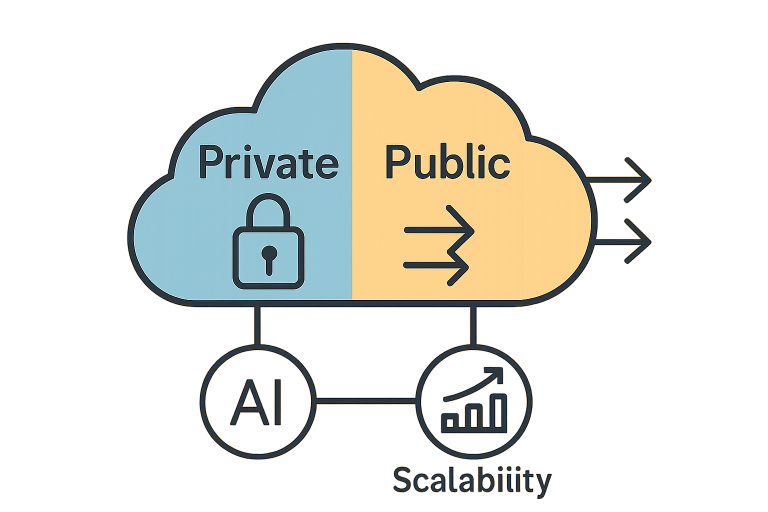Key Takeaways
- Hybrid cloud solutions offer a blend of private and public cloud benefits, providing flexibility and scalability.
- Integrating AI and machine learning enhances resource management and operational efficiency in hybrid environments.
- Adopting hybrid cloud strategies can lead to significant cost savings and improved performance.
Enterprises today require IT infrastructures that balance scalability, security, and compliance while enabling innovation. A hybrid cloud approach addresses these needs by combining the strengths of public and private environments, offering organizations the flexibility to expand quickly without losing control over sensitive data. This model supports digital transformation by integrating advanced capabilities such as AI-driven automation, predictive analytics, and edge computing to optimize workloads and improve performance. By uniting agility with governance, businesses can respond to market demands faster, streamline operations, and maintain regulatory standards. When managed effectively, hybrid strategies enhance resilience and cost efficiency and position organizations for sustainable growth in an increasingly competitive and technology-driven global marketplace.
Introduction
As organizations seek to keep pace with the demands of digital transformation, traditional IT setups often fail to balance agility and control. This gap has led to a surge in adopting hybrid cloud models seamlessly combining on-premises infrastructure with public cloud services. This integrated approach enables rapid innovation, scalability, and adaptability across an increasingly complex business landscape, making it a cornerstone for modern IT strategies.
The use of cloud in enterprise environments provides a robust, flexible framework for businesses that require robust security and compliance without sacrificing the ability to scale and optimize costs. Leveraging hybrid cloud allows companies to place sensitive data and mission-critical workloads in private clouds while using public cloud resources for dynamic scaling, analytics, and disaster recovery.
Understanding Hybrid Cloud Architecture
Hybrid cloud architecture facilitates the integration of on-premises data centers (private cloud) with public cloud services. This solution isn’t about simply connecting different cloud environments—instead, it’s about orchestrating workloads, data, and applications to dynamically allocate resources, maintain operational resilience, and support data liquidity across platforms. By leveraging the right mix of security, compliance, and operational agility, businesses can create highly tailored IT environments that meet unique needs while providing a unified user experience.
One of the defining characteristics of hybrid architecture is its ability to support workload portability. Organizations can move information and applications between clouds as needed—whether that’s to enhance performance, control operating costs, or maintain regulatory compliance. Gartner notes that by 2025, over 85% of enterprises will have a cloud-first principle, a testament to the accelerating need for hybrid and multi-cloud strategies across industries.

Benefits of Hybrid Cloud Solutions
- Flexibility: Businesses can choose the optimal environment for each workload, balancing performance and cost considerations.
- Scalability: Public cloud resources can be allocated elastically as demand fluctuates, ensuring uninterrupted service for mission-critical business processes.
- Cost Efficiency: Organizations can minimize capital expenditures by transferring less sensitive, high-volume processes to the public cloud and reducing reliance on expensive physical infrastructure.
- Enhanced Security: Sensitive assets can retain the protection of private, on-premises environments, meeting both external compliance and internal risk mitigation policies.
Integrating AI and Machine Learning
Emerging AI and machine learning frameworks transform resource provisioning within hybrid cloud environments. These intelligent systems can analyze usage trends, predict peak load periods, and dynamically reallocate resources for optimal efficiency. For example, leveraging machine learning models to manage microservices in the cloud can accelerate task execution and reduce unnecessary overhead expenses. According to research published in AI-Driven Resource Allocation Framework for Microservices in Hybrid Cloud Platforms, automated provisioning can realize up to 40% savings while minimizing bottlenecks and operational downtime compared to non-automated resource management approaches.
Real-World Applications
Hybrid cloud is gaining traction across various verticals, from financial services and healthcare to retail and manufacturing. In the UK, for example, hybrid cloud adoption is rising rapidly as businesses seek to modernize infrastructure and boost agility while meeting strict data sovereignty requirements. A recent TechRadar study shows that 31% of companies actively pursue hybrid solutions to support critical workloads, ensure high availability, and adapt to shifting regulatory landscapes.
Challenges and Considerations
- Complexity: Orchestrating multiple cloud environments—each with its own architecture and policies—can demand advanced management tools and a skilled IT workforce.
- Security Risks: Hybrid models increase the potential attack surface. It is paramount to ensure robust, consistent security policies and identity management across interconnected platforms.
- Compliance: Navigating a matrix of regulations—especially for international organizations—can complicate decisions about where and how data is processed and stored.
Best practices call for implementing unified management platforms, adopting automation to manage provisioning and monitoring, and defining clear data governance strategies aligning with business objectives and legal requirements. For further reading on strategies and issues surrounding hybrid cloud deployments, refer to CSO Online.
Future Trends
- Edge Computing Integration: Incorporating edge computing with hybrid environments ensures data can be processed where it is generated, reducing latency and improving real-time analysis for sectors such as healthcare, IoT, and manufacturing.
- Enhanced Security Measures: Implementing zero-trust security models, powered by AI-based anomaly detection, will become increasingly vital for maintaining robust, holistic security across interconnected clouds.
- Sustainability Initiatives: Energy-efficient design, automation, and green data centers are becoming more prominent as companies look to shrink their carbon footprint while maximizing computing performance and reducing waste.
Conclusion
Hybrid cloud solutions embody a strategic balance between flexibility, security, and future-readiness, making them a cornerstone of modern enterprise IT. They allow organizations to harness the scalability of public cloud resources while maintaining the control, customization, and compliance offered by private environments. This dual capability is critical for businesses navigating digital transformation, where speed and innovation must coexist with regulatory requirements and risk management. By leveraging advanced technologies such as AI-driven automation, predictive analytics, and edge computing, hybrid cloud environments empower companies to streamline processes, optimize resource allocation, and support data-intensive workloads. At the same time, careful attention to governance and cybersecurity ensures resilience and trust. Ultimately, hybrid cloud strategies create a foundation for sustained agility, efficiency, and scalable business growth.

